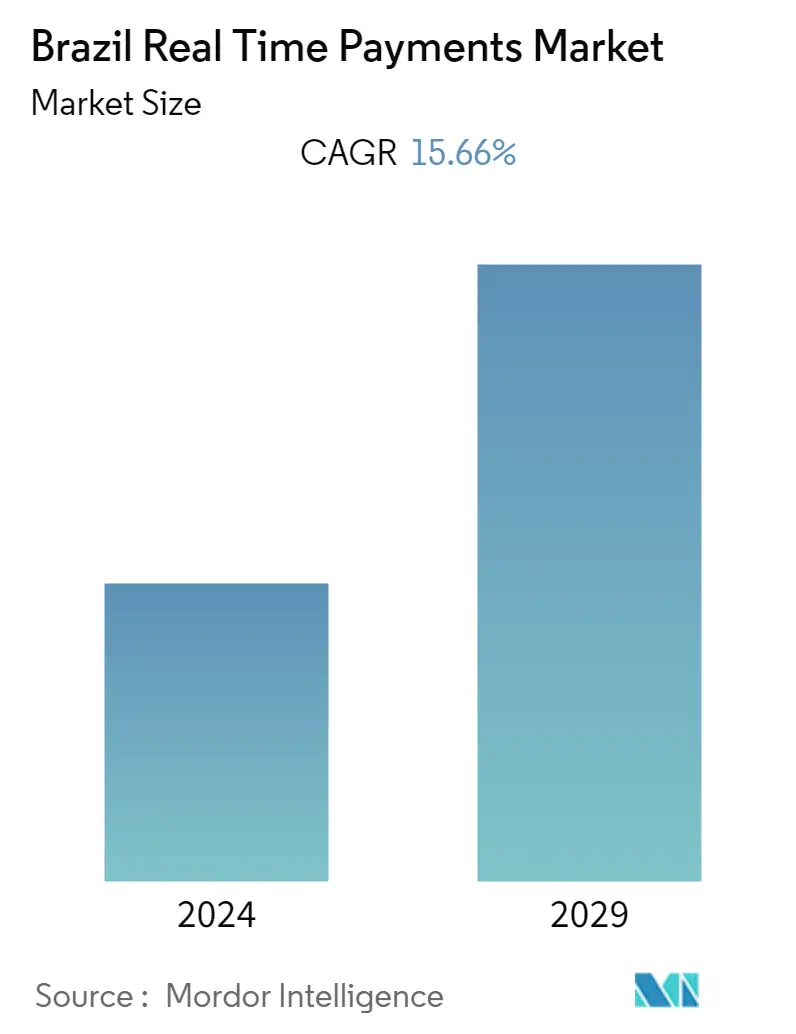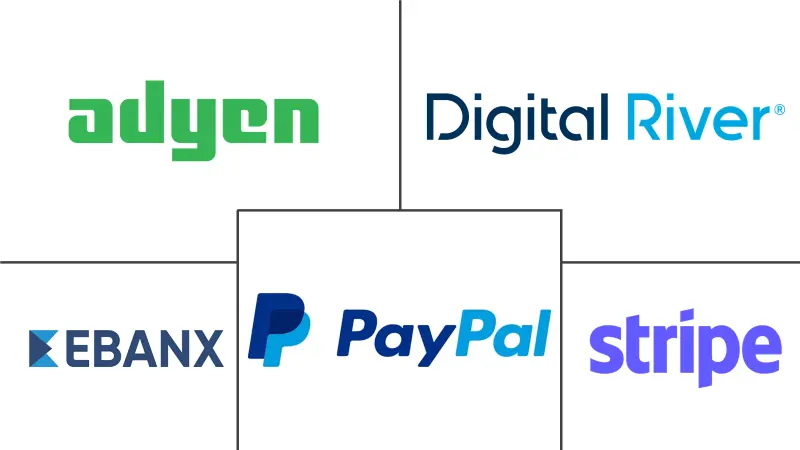Market Size of Brazil Real Time Payments Industry

| Study Period | 2019 - 2029 |
| Base Year For Estimation | 2023 |
| Forecast Data Period | 2024 - 2029 |
| Historical Data Period | 2019 - 2022 |
| CAGR | 15.66 % |
| Market Concentration | Medium |
Major Players
*Disclaimer: Major Players sorted in no particular order |
Brazil Real Time Payments Market Analysis
The Brazilian Real-Time Payments Market is expected to register a CAGR of 15.66% over the forecast period (2022 - 2027). With consumers' shift towards digital payments and increased internet penetration, the real-time payments market is growing rapidly in the country.
- After the outbreak of covid-19 and the shutdown of various businesses all over the world, including Brazil, the mode of payment in Brazil has also been enhanced by making the economy more independent of cash payments. This is made possible by introducing fast payment systems like real-time payment systems in which the payer and the payee are directly connected without the involvement of any third party.
- Moreover, Instant payment technology is, over time, being adopted by most countries as an advancement in payment infrastructure by ensuring the payment transaction is done without any delays or interruption and with a faster speed than conventional payment methods.
- For instance, In 2020, Brazil's Central Bank introduced Pix, a real-time payment system. According to World Economic Forum, Pix enabled 40 million users to make their first bank transfer. Throughout 2021, many updates have been made in Pix, like the advancement of the payment of invoices with scheduling and automatic calculation of interest, fines, and discounts. According to central bank data, Pix's payments volume is equivalent to 80 percent of credit and debit card transactions across the country.
- Factors like increasing smartphone penetration and the usage of e-commerce, social media, and the tech-savvy youth in the country are promoting the growth of Brazil real-time payment market.
- Furthermore, organizations are coming up with innovative payment solutions in the country. For instance, In June 2022, Zippi, a Brazil-based fintech company, announced that it had raised USD 16 million for a credit solution via PIX for micro-entrepreneurs. The solution enables micro-entrepreneurs to access working capital to pay suppliers through PIX, Brazil's real-time payment system.
Brazil Real Time Payments Industry Segmentation
A real-time payments system comprises technology that instantaneously transfers money between banks and banking systems.
The study tracks the current market scenario and the key developments in the Real-Time Payment market in Brazil. Given the evolving nature of the market landscape, the major real-time payment providers operating in the country are analyzed in detail, based on their current business model and relative positioning. The Brazil Real-Time Payments Market is Segmented by Type of Payment (peer-to-peer (P2P), peer-to-business (P2B)).
| By Type of Payment | |
| P2P | |
| P2B |
Brazil Real Time Payments Market Size Summary
The Brazilian real-time payments market is experiencing significant growth, driven by a shift towards digital payment solutions and increased internet penetration. The COVID-19 pandemic accelerated this transition, prompting a move away from cash-dependent transactions to more efficient, fast payment systems. The introduction of systems like Pix by Brazil's Central Bank has been pivotal, enabling millions to engage in digital transactions seamlessly. This shift is further supported by the rise in smartphone usage, e-commerce, and a tech-savvy population, which collectively enhance the adoption of real-time payment technologies. The market is also witnessing innovative solutions from fintech companies, such as Zippi's credit offerings for micro-entrepreneurs, which leverage Pix for financial transactions.
The competitive landscape of Brazil's real-time payments market is marked by strategic partnerships and expansions by key players. Companies like Adyen, PayPal, and EBANX are actively enhancing their service offerings to capture a larger market share. The government's efforts to promote digital payments, including the re-launch of WhatsApp's P2P payment services, further bolster market growth. Additionally, international collaborations, such as Brazil's partnership with the United Kingdom, aim to accelerate digital infrastructure development. These initiatives, alongside regulatory advancements like the introduction of payment initiation service providers, underscore the market's dynamic nature and its potential for continued expansion.
Brazil Real Time Payments Market Size - Table of Contents
-
1. MARKET INSIGHTS
-
1.1 Market Overview
-
1.2 Industry Attractiveness-Porter's Five Force Analysis
-
1.2.1 Bargaining Power of Suppliers
-
1.2.2 Bargaining Power of Buyers/Consumers
-
1.2.3 Threat of New Entrants
-
1.2.4 Threat of Substitute Products
-
1.2.5 Intensity of Competitive Rivalry
-
-
1.3 Evolution of the payments landscape in Brazil
-
1.4 Key market trends pertaining to the growth of cashless transaction in Brazil
-
1.5 Impact of COVID-19 on the payments market in Brazil
-
-
2. MARKET SEGMENTATION
-
2.1 By Type of Payment
-
2.1.1 P2P
-
2.1.2 P2B
-
-
Brazil Real Time Payments Market Size FAQs
What is the current Brazil Real Time Payments Market size?
The Brazil Real Time Payments Market is projected to register a CAGR of 15.66% during the forecast period (2024-2029)
Who are the key players in Brazil Real Time Payments Market?
Adyen, PayPal Payments Private Limited, Digital River, Inc, EBANX Ltda and Stripe, Inc. are the major companies operating in the Brazil Real Time Payments Market.

